
TNU Journal of Science and Technology
229(06): 170 - 177
http://jst.tnu.edu.vn 170 Email: jst@tnu.edu.vn
ADSORPTION OF ARSENATE IN WATER BY MAGNETIC ZnFe2O4/α-
Fe2O3/BIOCHAR NANOCOMPOSITES: ISOTHERM AND KINETIC STUDIES
Nguyen Thi Luyen*, Bui Minh Quy
TNU – University of Sciences
ARTICLE INFO
ABSTRACT
Received:
18/3/2024
The adsorption of arsenate into the water by magnetic ZnFe2O4/α-
Fe2O3/biochar nanocomposite (MBC) were investigated in this article.
Batch mode adsorption studies were carried out by varying pH, shaking
temperature, and initial As5+ concentration. The adsorption of As5+ was
pH dependent and showed maximum removal efficiency of As5+ at pH
8.0. Adsorption studies of 5–35 mg/L initial As5+ concentration were
carried out at pH 8.0 and temperature of 303 K, 313 K, and 323 K.
Langmuir and Freundlich, Temkin isotherm adsorption models were
used to analyze the experimental data. The kinetic adsorption was
studied using pseudo-first-order, pseudo-second-order, and Elovich
models. The pseudo-second-order and Langmuir models fitted the
adsorption of As5+ onto MBC. The adsorption of arsenate onto MBC
was mainly controlled by the chemisorption and physisorption
adsorption mechanisms. MBC could be easily recovered and reused
using an external magnetic field. MBC had the potential to be high
adsorption efficiency.
Revised:
23/5/2024
Published:
24/5/2024
KEYWORDS
Adsorption
Arsenic anions
Biochar
Magnetic, ZnFe2O4/α-Fe2O3
Isotherm model
Kinetic model
HẤP PHỤ ARSENATE TRONG NƯỚC BẰNG VẬT LIỆU TỔ HỢP NANO TỪ
TÍNH ZnFe2O4/α-Fe2O3/THAN SINH HỌC: NGHIÊN CỨU NHIỆT, ĐỘNG HỌC
Nguyễn Thị Luyến*, Bùi Minh Quý
Trường Đại học Khoa học – ĐH Thái Nguyên
THÔNG TIN BÀI BÁO
TÓM TẮT
Ngày nhận bài:
18/3/2024
Sự hấp phụ arsenate trong nước bằng vật liệu tổ hợp nano từ tính
ZnFe2O4/α-Fe2O3/than sinh học (MBC) đã được nghiên cứu trong bài
báo này. Các nghiên cứu thực nghiệm hấp phụ được thực hiện bằng
cách thay đổi độ pH, nhiệt độ rung lắc và nồng độ As5+ ban đầu. Khả
năng hấp phụ As5+ phụ thuộc vào pH và cho thấy hiệu quả loại bỏ As5+
tối đa ở pH 8.0. Nghiên cứu sự hấp phụ asen ở nồng độ ban đầu là 5–35
mg/L được thực hiện ở pH 8.0 và nhiệt độ 303 K, 313 K và 323 K. Mô
hình hấp phụ đẳng nhiệt Langmuir, Freundlich và Temkin được sử dụng
để phân tích số liệu thực nghiệm. Động học hấp phụ được nghiên cứu
bằng mô hình giả bậc nhất, giả bậc hai và mô hình Elovich. Các mô
hình giả bậc hai và mô hình Langmuir được làm khớp phù hợp với sự
hấp phụ As5+ trên MBC. Sự hấp phụ arsenate bằng vật liệu MBC chủ
yếu được kiểm soát bởi cơ chế hấp phụ hóa học và vật lý. MBC có thể
dễ dàng được thu hồi và tái sử dụng bằng cách sử dụng từ trường bên
ngoài. MBC có tiềm năng đạt được hiệu suất hấp phụ cao.
Ngày hoàn thiện:
23/5/2024
Ngày đăng:
24/5/2024
TỪ KHÓA
Hấp phụ
Anion Arsen
Than sinh học
Từ tính ZnFe2O4/α-Fe2O3
Mô hình nhiệt học
Mô hình động học
DOI: https://doi.org/10.34238/tnu-jst.9919
* Corresponding author. Email: luyennt@tnus.edu.vn

TNU Journal of Science and Technology
229(06): 170 - 177
http://jst.tnu.edu.vn 171 Email: jst@tnu.edu.vn
1. Introduction
Water, which is required for the survival of all living things on Earth, is facing a major global
challenge as a result of environmental pollution. Arsenic (As) is one of the most well-studied
heavy metals found in water. In recent years, magnetic biochar nanocomposite materials with
numerous functional groups and excellent chemical stability have been developed for water
treatment. These materials showed excellent ability to remove arsenic from water and have the
potential for practical applications [1] – [3]. Arsenic is typically removed through methods such
as oxidation, co-precipitation, membrane filtration, ion exchange, and adsorption [4]. Adsorption
has recently been identified as an effective method for arsenic removal due to its high efficiency,
low cost, and ease of use [2] – [8]. Among porous materials, magnetic nanoparticle-based biochar
has received significant attentions [1], [2], [9]. The porous structure and magnetism of the
materials allow contaminants to be transported and captured quickly. Several studies have
demonstrated their excellent adsorption performance and potential practical use in arsenic
removal. Zhang et al. synthesize ℽ-Fe2O3-based biochar material composite through pyrolysis
method, and used it to adsorb As5+ from water with maximum adsorption amount of
3.147 mg·g−1. Wen et al. investigated the excellent adsorbent of arsenic from water on biochar
supported MnFe2O4 magnetic nanocomposite [1].
Novel ternary magnetic ZnFe2O4/α-Fe2O3/biochar nanocomposite materials have high
adsorption capacities and remarkable stability for removing pollutants in water [2]. Our previous
study found that the ZnFe2O4/α-Fe2O3/biochar nanocomposite was successfully fabricated by one-
step pyrolysis in oxygen-limited environment and used as an excellent adsorbent for simultaneous
removal of direct red 79 species from water environment. This study investigates the effect of
various experimental conditions, such as initial pH, initial arsenic concentration, shaking
temperature, and contact time, as well as thermodynamics models on the ability to remove arsenic
from water. Finally, the regeneration, and reusability studies of ZnFe2O4/α-Fe2O3/biochar
nanocomposites were explored with the goal of evaluation the practical application.
2. Materials and methods
2.1. Materials
Peanut shells were collected from the local market in the Vietnamese province of Thai
Nguyen and used as precursor materials for biochar production. Zinc Chloride Hexahydrate
(ZnCl2.6H2O ≥ 98%) and Iron (II) Chloride Tetrahydrate (FeCl2.4H2O ≥ 98%) were acquired
from Sigma Aldrich. Silver Nitrate (AgNO3, 98%) was acquired from Xilong, China. Disodium
arsenate (Na2HAsO4) were guaranteed reagent (purity > 99.5%). All of the water used in the
experiments was distilled water.
2.2. Methods
2.2.1. Preparation of MBC
MBC adsorbent material was synthesized via direct pyrolysis in oxygen-limited conditions
with the mass ratio of ZnCl2.6H2O and FeCl2.4H2O was set to 1 and activation temperature was
set at 700o C. The process of preparing MBC and properties are presented in detail in a previous
study [2].
2.2.2. Adsorption experiment
The adsorption process of As5+ on MBC was studied through studying the effects of pH,
adsorption time, temperature and initial concentration of As5+. Adsorption experiments were
performed on a model MAXQ 4000 Thermo Scientific with a shaking speed of 200 rpm.
Typically, 25 mL of As5+ solution with a certain concentration and 25 mg of MBC were added
into 50 mL glass flasks and shaken for a certain time. The effect of pH on the adsorption

TNU Journal of Science and Technology
229(06): 170 - 177
http://jst.tnu.edu.vn 172 Email: jst@tnu.edu.vn
properties of MBC toward As5+ was studied using an As5+ solution with an initial concentration
of 20 mg L-1, and then adjusting the pH of the solution in the range of 2 to 9 using NaOH or HCl
solution (0.1 mol L-1). The kinetic experiments were carried out with As5+ initial concentrations
of 20 mg/L at a pH of 8 at different temperatures (303 K, 313 K, and 323 K) and various time
intervals (30 min to 20 h). The adsorption isotherm experiments were carried out by mixing 25
mL of As5+ solutions with various initial As5+ concentrations ranging from 5 mg L-1 to 35 mg L-1
at a pH of 8 for 360 min. The As5+ concentrations in the liquid phase samples were determined by
using inductively coupled plasma-atomic emission spectrometry (ICPAES). As5+ concentrations
on the solid phase were calculated based on the initial and final aqueous concentrations.
The removal efficiency (%) and the adsorption capacity of samples (mg/g) were calculated
using the following equations, respectively:
(1)
(2)
3. Results and discussion
3.1. Effect of pH
The surface of MBC could be positively charged or negatively charged. Absorbent pore walls
had several surface functional groups. The pH dependence of As5+ adsorption is mostly
determined by the kind and ionic state of these functional groups, as well as the chemistry of the
adsorbate in solution. The solution pH is a crucial parameter for heavy metal removal from
aqueous solution because it affects adsorbate solubility, counter ion concentration on adsorbent
functional groups, and the degree of ionization of the adsorbate during reaction [7]. As5+ removal
was investigated as a function of pH over a pH range of 2-9 on MBC at the initial concentration
of 20 mg/L as shown in Figure 1.
Figure 1. Effect of pH on As5+ adsorption on ZnFe2O4/α-Fe2O3/biochar
As seen in Figure 1, metal ion adsorption is minimal at pH 3 and increases with increasing
pH, and reaches its highest value at pH 8. Compared to acidic media, alkali solutions had overall
heavy metal removal values that were significantly greater. Anionic arsenic adsorption is thought
to decrease at lower solution pH, where the magnetic material behaves like a weak acid and can
be destroyed by forming a negative surface [6], [8]. The increase in adsorption with increasing
pH may be caused by the dominance of electrostatic attraction. Hence, pH 8.0 was taken as the
optimal values for further studies of As5+ adsorption on MBC.

TNU Journal of Science and Technology
229(06): 170 - 177
http://jst.tnu.edu.vn 173 Email: jst@tnu.edu.vn
3.2. Effect of contact time
The amount of As5+ adsorbed on MBC was studied as a function of shaking time at initial
concentrations 20 mg/L of As5+ at different temperature 303 K, 313 K, 323 K, 0.025 g of
adsorbent and pH 8.0. The results are given in Figure 2(a). General, the removal and amount of
As5+ adsorbed was found to be increased with increase in temperature. In the first 360 minutes of
contact, MBC removes a greater quantity of As5+, and the equilibrium is reached in 600 minutes.
The fact that the As5+ ion reaches its maximal removal in 360 minutes and then stops adsorbing
further indicates that the adsorption is very rapid. At an early stage of adsorption for the As5+, a
substantial number of empty sites with active functional groups were available on MBC. When
the temperature rose from 303 to 323 K, the equilibrium adsorption of As5+ increased from 9.23
to 9.82 mg/g and the removal efficiency of As5+ increased from 36.80 to 39.15%, respectively.
3.3. Kinetics of adsorption
The adsorption of As5+ on the MBC was fast and reached equilibrium within 10 h (Figure 2a).
The relatively fast kinetics suggests that biochar might play an import role in the dispersion of
ZnFe2O4/α-Fe2O3 nanoparticles which efficiently increased the surface area of the particles and
active sites of metal oxides by separation [9]. The adsorption kinetics of the As5+ were
investigated using the pseudo-first-order rate equation, the pseudo-second-order rate equation,
and the Elovich model rate equation. The three sorption kinetic equations are expressed as
follows in eqn (3)-(5):
The pseudo-first-order equation:
ln(qe - qt) = lnqe – k1t (3)
The pseudo-second-order equation:
(4)
Elovich equation:
qt =
(5)
where k1 is the rate constant of the pseudo-first-order equation (min-1), and k2 is the rate constant
of the pseudo-second-order equation (g mg-1 min), α (mg/g. min) is the initial adsorption rate, β
(g/mg) is desorption constant during each experiment, qe is the adsorption capacity at equilibrium
(mg g-1), and qt is the adsorption capacity at any time t (mg g-1).
Table 1. The adsorption kinetics parameters of As5+on ZnFe2O4/α-Fe2O3/biochar
Pseudo-first-order
Pseudo-second-order
Elovich model
T(K)
qe,exp
(mg/g)
k1x10-3
(min-1)
qe,cal
(mg/g)
R2
k2x10-3
(g mg-1
min)
qe,cal
(mg/g)
R2
α
(mg/g.
phút)
β (g/mg)
R2
303
9.12
0.00
2.387
0.61
3.20
9.528
0.999
0.672
0.553
0.851
313
9.46
0.00
2.773
0.76
3.08
9.604
0.999
0.688
1.596
0.886
323
9.69
0.00
2.664
0.67
2.86
9.771
0.999
0.706
2.398
0.873
The kinetics of adsorption As5+ by MBC were analyzed at different temperatures. Figure 2 (a,b,c)
presents the results of fitting experimental data to the first-order, the pseudo-second-order, and the
Elovich models, respectively. Best-fit parameters of the models are listed in Table 1. As shown in
Table 1, the value of qe calculated using the first-order kinetic model was much smaller than the value
of the equilibrium adsorption capacity (qe,exp) obtained from the experiment. In contrast, the value of
qe calculated using the second order kinetic model was similar to qe,exp. This means that the first order
kinetic model did not fit the absorption process of As5+ on the MBC compared to the second order
kinetic model. Moreover, the correlation coefficient (R2) of the second order kinetics model was
almost 0.999 and was greater than that of the first order kinetics model. This result indicates that the

TNU Journal of Science and Technology
229(06): 170 - 177
http://jst.tnu.edu.vn 174 Email: jst@tnu.edu.vn
second order model is the most suitable in describing the adsorption kinetics of As5+ on MBC, and
this process is primarily controlled by chemical adsorption [2].
Figure 2. (a) Effect of contact time on adsorption of As5+ by ZnFe2O4/α-Fe2O3/biochar;
(b) pseudo-first-order kinetic model; (c) pseudo-second-order kinetic model;
and (d) Elovich model for the adsorption of As5+ by ZnFe2O4/α-Fe2O3/biochar
3.4. Adsorption isotherms
The adsorption isotherm is one of the important factors in designing an adsorption system. In
fact, the adsorption isotherm describes the interaction between the adsorbent surface and the
adsorbent. In this study, the adsorption isotherm experiments were carried out by mixing 25 mL
of As5+ solutions with various initial As5+ concentrations (5, 10, 15, 20, 25, 30, 35 mg/L), 25 mg
of the ZnFe2O4/α-Fe2O3/biochar at temperatures 303K, for 360 min. To investigate the isotherm
behaviors of As5+ adsorption onto the ZnFe2O4/α-Fe2O3/biochar, the theories of Langmuir [10],
Freundlich [11], and Temkin [12], were employed. The equations of the theories are as follows:
Langmuir isotherm:
(6)
Freundlich isotherm:
(7)
Temkin isotherm:
BT.ln (8)

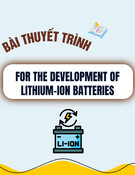
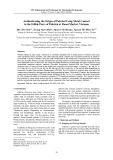

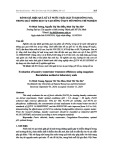
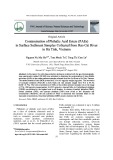

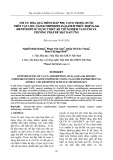

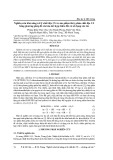
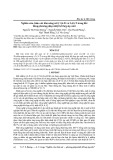

![Tài liệu Vi sinh vật môi trường [Mới nhất]](https://cdn.tailieu.vn/images/document/thumbnail/2025/20251123/ngkimxuyen/135x160/21891763953413.jpg)
![Sổ tay truyền thông Phân loại chất thải rắn sinh hoạt trên địa bàn tỉnh Quảng Nam [Chuẩn nhất]](https://cdn.tailieu.vn/images/document/thumbnail/2025/20251114/kimphuong1001/135x160/1701763094001.jpg)


![Quản lý chất thải nguy hại: Sổ tay Môi trường [Chuẩn nhất]](https://cdn.tailieu.vn/images/document/thumbnail/2025/20251029/kimphuong1001/135x160/9011761720170.jpg)









